Click on images to enlarge
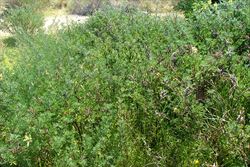
infestation on a coastal sand dune (Photo: Sheldon Navie)
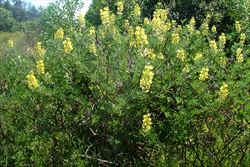
habit (Photo: Sheldon Navie)

close-up of the sparsely hairy stems (Photo: Sheldon Navie)

leaves (Photo: Sheldon Navie)

flower cluster (Photo: Sheldon Navie)
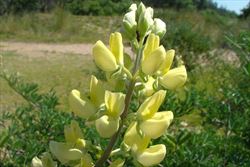
close-up of the pea-shaped flowers (Photo: Sheldon Navie)
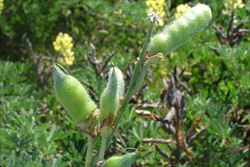
close-up of immature fruit (Photo: Sheldon Navie)
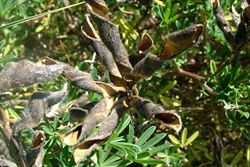
old fruit (Photo: Sheldon Navie)
Scientific Name
Lupinus arboreus Sims
Family
Fabaceae (Queensland, the ACT, Victoria, Tasmania, and the Northern Territory)Fabaceae: sub-family Faboideae (New South Wales)Leguminosae (South Australia)Papilionaceae (Western Australia)
Common Names
bush lupin, bush lupine, coastal bush lupine, lupin, lupine, tree lupin, tree lupine, yellow tree lupin, yellow bush lupine
Origin
Native to south-western USA (i.e. California).
Naturalised Distribution
Naturalised in south-eastern Australia (i.e. in southern and eastern Victoria and the coastal districts of Tasmania).
Also naturalised overseas in the UK, temperate Asia, New Zealand, southern South America (i.e. Chile) and beyond its native range in the USA (i.e. in Washington and Oregon).
Legislation
Not declared or considered noxious by any state government authorities.
Notes
Tree lupin (Lupinus arboreus) is regarded as an environmental weed in Victoria and Tasmania, and is a "sleeper weed" or potential environmental weed in other parts of southern Australia. Although not yet very widely naturalised in this country, this species is thought to be a threat to coastal dune systems throughout much of southern Australia. Tree lupin (Lupinus arboreus) reduces species diversity in invaded areas and increases nitrogen levels in the soil. This promotes the invasion of other weeds, including exotic grasses and thistles. It re-sprouts after fire and its long-lived hard seed are also stimulated to germinate by fire.
Tree lupin (Lupinus arboreus) is a significant weed species in the coastal regions of Tasmania, and is thought to pose a serious environmental threat to coastal dunes and coastal scrub vegetation in this state. It is a major weed of coastal sand dunes around Strahan, in western Tasmania, and is also a common coastal weed in the south-eastern parts of the state. It is also a priority environmental weed on King Island, off the north coast of Tasmania. Tree lupin (Lupinus arboreus) also appears on several local environmental weed lists in this state (e.g. in Latrobe, Kentish and Kingborough Municipalities) and has been recorded in Tasman National Park.
In Victoria, tree lupin (Lupinus arboreus) is regarded as a threat to coastal dune vegetation, heathlands, heathy woodlands, as well as alpine and sub-alpine vegetation in the north-east of the state. This species is also invasive in coastal vegetation in New Zealand.

